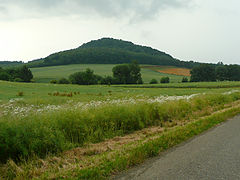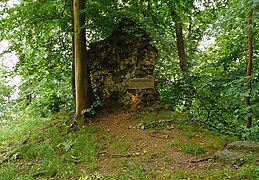Brackenburg castle ruins
| Brackenburg castle ruins | ||
|---|---|---|
|
About 6 m high section of the wall of the former castle, |
||
| Alternative name (s): | Brackenberg ruins | |
| Creation time : | 1303 / '04 to 1353 | |
| Castle type : | Hilltop castle | |
| Conservation status: | Trench, wall and wall remains | |
| Standing position : | duke | |
| Construction: | Basalt quarry stone | |
| Place: | on the Brackenberg near Scheden - Meensen ( Lower Saxony ) |
|
| Geographical location | 51 ° 25 '59 " N , 9 ° 44' 51" E | |
| Height: | 461 m above sea level NHN | |
|
|
||
The castle ruin Brackenburg (also called ruin Brackenberg ) is a castle ruin near Meensen in the district of Göttingen , Lower Saxony ( Germany ).
Geographical location
The ruin the former Höhenburg are located in the central part of the natural park Münden on the Brackenberg ( 461 m above sea level. NHN ), a heavily wooded basalt in southeastern Schedener Gemeindeteil Meensen.
Castle ruins
From the former castle, which was built on the summit area of basalt stones are still digging - Wall- and wall remains available. Remains of outer walls can be seen on an area of 20 × 23 meters, the wall thickness being around 1.8 m. They include a 10 x 23 m large and basement building on the west side, as Palas is considered. The functional interpretation is based on the found material of glass, ceramic and bone remains recovered from the slope below the building. Another building on the southeast corner was 7.5 × 12 m in size. On the south-western part of the summit region there is a tower-like part of the wall, which rises almost 6 m above the terrain. The castle did not have a keep or a tower. Below the mountain top, it was surrounded by a moat .
In 2002, students of geoinformatics at the University of Hanover carried out a relief mapping of the fortifications and measured their floor plans. As a result, Brackenburg produced a virtual 3D model with an attempt to reconstruct the buildings. Such measurements of archaeologically significant facilities have long been taking place in cooperation between the University of Hanover and the Lower Saxony State Office for Monument Preservation .
The steep slopes of the castle, which were probably artificially created when it was built, still make the ascent to the core area of the freely accessible ruin difficult.
View from the northeast to the Brackenberg ; Location of the Brackenburg castle ruins
history
Duke Ernst I had the former castle in the years 1303/04 to 1353 near the former military and trade route of Hann. Münden to Göttingen was built as a strategically important protection against attacks by Hessian princes. The first residents of the castle were the lords of Stockhausen. According to Johannes Letzner , however, the Brackenburg is said to be much older and was built in 1079 by the nobles von Berlepsch . They should have lived in the castle for many years afterwards.
The castle with the villages of Atzenhausen , Lippoldshausen , Meensen , Mollenfelde , the Wüstung Posthagen and the Leineholz was pledged with court and right for 400 silver marks to the brothers Hermann and Heinz von Kolmatsch from Thuringia by Duke Otto den Quaden .
In 1411, Duke Otto the One-Eyed decided to launch a large army expedition against the robber barons on the Brackenburg. The castle was besieged and shot at until the heavily damaged structure could be captured after about three weeks. In 1427 Otto gave the castle to his wife Agnes. From the middle of the 15th century, the Lords of Gieme appear as the owners of the castle, as Janus von Gieme is attested as the owner in 1458. A short time later, the castle was besieged and looted, the von Gieme family suffered enormous material damage and died out shortly afterwards. The damage to the castle was soon repaired, however, and the owners of the castle were subsequently for 22 years the Lords von Boventen , alongside the Junkers von Grone , who also lived in their own castle house on the Brackenburg.
In 1486, while the big cities were feuding , the Brackenburg was burned down. At that time the castle belonged to Hermann von Haus , a relative of Bertholt von Hildesheim . The people of Göttingen, under the leadership of Captain Hinterthür, marched against the castle, conquered it and took Hermann von Haus prisoner. They then sold the castle to the Lords of Adelebsen . Towards the end of the 16th century there is evidence that the Lords of Bodenhausen owned the castle. A certificate, issued on December 9, 1573 in Münden , states that Wilken the Elder of Bodenhausen paid Laetare in 1574 Duke Erich II of Münden 5000 Rhenish gold guilders and 6000 hard Reichstaler as pledge for the house and office of Brackenberg. Wilken was administrator of the house and office for six years. In 1583 the sum was paid again by Wilken's son, Melchior von Bodenhausen. The castle later fell into oblivion, but experienced a new surge in popularity when, as part of Goethe's " Götz von Berlichingen ", interest in knighthood increased again. The Brackenburg should receive a similar spectacle. The play was printed in 1776 and premiered ten years later in Göttingen under the title "Hermann Riedel von der Brackenburg or obstinacy harms marriages". Since then it has been left to decay.
literature
- Ernst Andreas Friedrich : The ruins of the Brackenburg . In: If stones could talk . tape IV . Landbuch-Verlag, Hannover 1998, ISBN 3-7842-0558-5 , p. 150-151 .
- Hans-Wilhelm Heine , Stefan Hesse, Frank Thiemann: Castle surveying - the example of Brackenburg near Meensen (district of Göttingen) In: Mamoun Fansa , Frank Both, Henning Haßmann (editor): Archeology | Land | Lower Saxony. 400,000 years of history. Landesmuseum für Natur und Mensch, Oldenburg 2004. pp. 565–567.
Web links
- Entry by Stefan Eismann on the Brackenburg castle ruins in the scientific database " EBIDAT " of the European Castle Institute
- Excursion to Brackenberg and Brackenburg (castle history and photos), on brack.de
- Brackenburg , in: Reconstruction drawings of German castles , on burgrebaus.de
- Axel Schmidt: The forgotten ruins of Brackenberg in: Hessische / Niedersächsische Allgemeine from July 23, 2010
Individual evidence
- ↑ Georg Heinrich Klippel: Göttingen and its surroundings. A paperback especially for students and travelers . Ed .: Heinrich Veldeck. tape 2 . Rosenbusch, Göttingen 1824, p. 221 .
- ^ Heinrich Lücke: Castles, palaces and mansions in the area of the lower Werra. Issue 2 . Published by H. Lücke, Parensen 1924, p. 33 .




